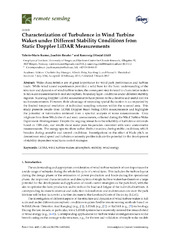Characterization of turbulence in wind turbine wakes under different stability conditions from static Doppler LiDAR measurements
Peer reviewed, Journal article
Published version

Åpne
Permanent lenke
https://hdl.handle.net/1956/18402Utgivelsesdato
2017-03-05Metadata
Vis full innførselSamlinger
- Geophysical Institute [1195]
Originalversjon
https://doi.org/10.3390/rs9030242Sammendrag
Wake characteristics are of great importance for wind park performance and turbine loads. While wind tunnel experiments provided a solid base for the basic understanding of the structure and dynamics of wind turbine wakes, the consequent step forward to characterize wakes is full-scale measurements in real atmospheric boundary layer conditions under different stability regimes. Scanning Doppler LiDAR measurements have proven to be a flexible and useful tool for such measurements. However, their advantage of measuring spatial fluctuation is accompanied by the limited temporal resolution of individual sampling volumes within the scanned area. This study presents results from LiDAR Doppler Beam Swing (DBS) measurements and highlights the potential of information retrieved from a spectral analysis of wake measurements. Data originate from three Windcube v1 and sonic anemometers, collected during the Wind Turbine Wake Experiment–Wieringermeer. Despite the ongoing research on the reliability of turbulence retrievals based on DBS data, our results show wake peak frequencies consistent with sonic anemometer measurements. The energy spectra show rather distinct maxima during stable conditions, which broaden during unstable and neutral conditions. Investigations on the effect of blade pitch on downstream wind speed and turbulence intensity profiles indicate the potential for the development of stability-dependent wind farm control strategies.
